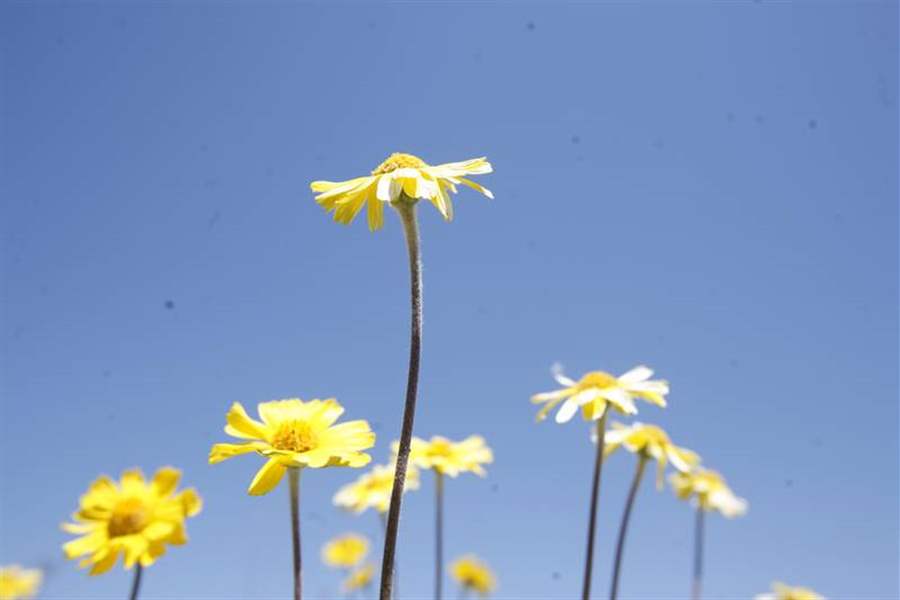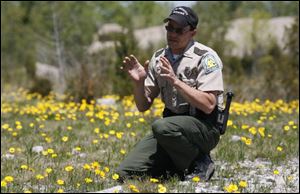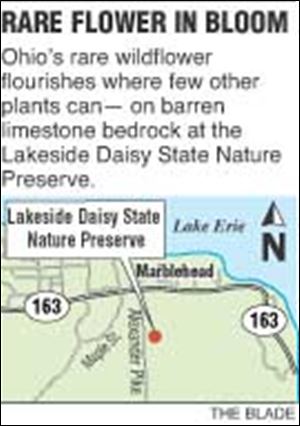
Daisy a diamond in the rough
5/10/2006
The Lakeside daisy grows in the limestone bedrock at Lakeside Daisy State Nature Preserve.

The Lakeside daisy grows in the limestone bedrock at Lakeside Daisy State Nature Preserve.
MARBLEHEAD, Ohio - For a delicate yellow flower no larger than a quarter, the endangered Lakeside daisy is a real survivor.
The plant is one of the state's rarest flowers, growing in a moonscape-like quarry on the Marblehead peninsula, protected within the Lakeside Daisy State Nature Preserve.
The daisy grows naturally in only two other places, the rocky Bruce Peninsula and Manitoulin Island, both in Ontario, Canada.
The plant shuns humus, rich soil, and shade in favor of limestone bedrock in full sunlight.

Gary Obermiller of the Ohio Department of Natural Resources discusses the Lakeside daisy's uniqueness while visiting the preserve.
"The worse [the land] looks, the better it is," says Gary Obermiller, north regional manager of the Ohio Department of Natural Resources' Division of Natural Areas & Preserves.
The flowers bloom from leafless, rubbery green stalks that grow from 6 inches to 11 inches high, thriving in an environment where few other plants can.
For folks who enjoy a rare glimpse of botanical magic, this is their weekend, when the flower is feted in the village of Marblehead's Lakeside Daisy Day Festival.
The flower blooms in May, and Mothers' Day is considered the pinnacle of its blooming time, Mr. Obermiller says.
The Lakeside daisy shares its rocky stage with several other hardy plants that thrive in the seemingly inhospitable quarry. Blue-eyed grass, with flowers the size and brilliance of tanzanite topping thin strands, sparkle among the gravel and rocks. Long-lived red cedar trees grow like bonsai plants, never gaining much height because of the lack of soil to extend a root system.

"This is a hostile environment and nutrient poor," Mr. Obermiller said on a tour of the preserve.
The preserve is home for a dozen rare plant species such as rock sandwort, balsam squaw-weed, and Great Plants Ladies-tresses.
But the Lakeside daisy steals the show each May, its heliotropic blossoms perched on top of a rubbery stem, tracking the sun through the course of the day.
Mr. Obermiller admits outside of the daisy's May showing, getting folks excited about the 19-acre preserve takes some effort.
"It's not an easy sell," he says. "But it's a botanical paradise."
Even buying the abandoned limestone quarry in 1988 took some effort. Standard Slag Co., which owned the site before it was purchased by Lafarge Corp., was reluctant to part with the land, Mr. Obermiller said.
The former quarry is about 40 feet below the rest of the peninsula. It had been mined for limestone years ago, but its current depth represents the capability of quarry equipment a century ago.
Across the road, LaFarge has a much deeper operation that sends stone on a conveyor belt across State Rt. 163 and onto freighters for transport across the Great Lakes.
Allison Cusick, a retired chief botanist for the state of Ohio, says it is likely that one of those stone shipments to northern Michigan is responsible for colonizing a section of the Upper Peninsula with the Lakeside daisy.
There, the daisy grows at the edge of a gravel road in Mackinac County.
"It's very possible the gravel came from Marblehead with seeds from the Lakeside daisy," said Mr. Cusick by telephone from his home in Columbus.
Other species of the daisy grow in the Great Plains and Rocky Mountains.
Mr. Cusick is the botanist who in 1991 established the nomenclature of the plant, Hymenoxys herbacacea.
Mr. Cusick, who plans to visit the quarry this weekend during the festival, will lead a nature program Sunday on Kelleys Island, where the Lakeside daisy is cultivated within the protected area of the state park.
Pat Hayes, president of the Kelleys Island Audubon Club, said the daisy was taken to the island in part to ensure there was another site nearby should something happen to the plants at the quarry.
Mr. Obermiller said the state obtained permission from federal authorities for the move because of the plant's protected status.
Kelleys Island's limestone environs mirror Marblehead's. In northeastern Illinois, botanists are restoring daisy fields at three protected sites, where it thrived before its habitat was destroyed, Mr. Cusick said.
The Lakeside Daisy State Nature Preserve is on Alexander Pike, which runs from the village of Marblehead to the opposite side of the peninsula. The preserve is open to the public, and a permit is no longer needed to enter.
Saturday's daisy festival begins at 10 a.m. Motorcycle enthusiasts will be showing off bikes, and vendors and crafters will be set up in James Park.
Quarry and lighthouse tours will be held all day, with shuttle service to the peninsula's historic landmarks.
Activities also are planned at the Keeper's House on the opposite side of the peninsula.
Contact Jim Sielicki at:
jsielicki@theblade.com
or 419-724-6078